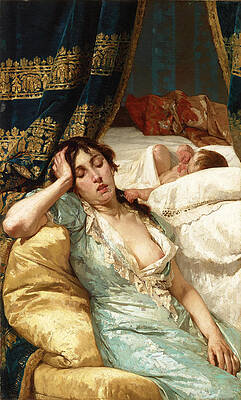Giuseppe Sciuti
Portrait of Alfio Tomaselli
Triumph of the Catanians over the Libyans
The joys of the good mother
Appius Claudius responds to Cineas to first leave Italy and then to negotiate Peace
Titus Quintus for the Freedom to the Greeks
Giuseppe Sciuti (Zafferana Etnea, Sicily, February 26, 1834- Rome, March 13, 1911) was an Italian painter.
Biography
His father, a pharmacist, insisted his son follow his trade. But he relented and allowed Giuseppe to study locally at age 15, and later with a small allowance of his father, in Catania. Where, he worked under Giuseppe Destefani, a scenographer, for six months. He also studied under the ornamental painter Giuseppe Rapisardi. Afterward he joined the studio of the painter Antonino Gandolfo.[1] By the age of 18, he was hoping to travel to either Florence or Rome to study, but an eruption of Etna destroyed his father's farms, and left his family impoverished. Giuseppe was forced to seek work under a local decorative painter. After 11 years of this work, and thanks to some frugality, he was able to travel to Florence, where he paints : The Widow and The Betrayed, which then exhibited at Catania, purchased by the City Government. Returning to Catania he completed profitable works of decoration. After two years after he left and went to Naples, where he displayed A Temptation at the annual exhibition of the Società Promotrice. He goes on further to paint You mothers of the country ; The prisoners after the capitulation of Castelnuovo; and An episode during the sack of Catania, exhibited at the Mostra annuale della Società Promotrice of Naples. He exhibited in Genoa: Domestic peace (1870).[2]
Proclamation of the Republic of Sassari (The Council), 1880, Sassari.
In addition to paintings depicting patriotic and Genre themes, after the 1870s, he also specialized in painting ancient Roman and Greek subjects (Neo-Pompeian subjects). He painted a large canvas Pindar exalts the winner of an Olympic Game exhibited at the National Exhibition in Milan, and donated to the Brera Academy. He also exhibited this painting at the Universal Exposition of Vienna, where it won a medal .Funeral of Timoleone (bought by City of Palermo)[3] and Uno sposalizio greco (bought by Brera Gallery in Milan). In 1875 from Naples he moves to Rome, and the next year wins a public contest to design frescoes for the Hall of the Provincial Council of Sassari, consisting of two historical paintings: Proclamation of the Sassarese Republic and the Triumphal entry of Gian Maria Angiol to Sassari. He has also painted: A Geography Lesson (also called Le Gioie della Buona Mamma 1877), exhibited at the Melbourne Exposition; La Corsa a Piedi (Ancient Roman subject) and After the meal for an Ancient Roman, exhibited at the Mostra Artistica di Milan. The Timoleon and Pindar were intended for the Hall of the Senate in Rome. In his La Vittoria d'Intera, he depicts the moment in which the Sicilian army has begins to defeat Hamilcar Barca's Carthaginian army. It was exhibited and sold at the 1888 Italian Exhibition of London.[4] In 1890, he painted the Episodio della spedizione di Pisacane a Sapri.[5]
Ceiling of the Collegiata of Santa Maria dell'Elemosina in Catania.
In 1896, he returned to paint the ceiling a cupola of the Basilica della Collegiata of Catania. He also painted the large work of Benessere e le Arti, now in Zafferan Etnea. In 1902-1905, Sciuti painted the ceilings of seven rooms in the Palazzo Calanna of Acireale, in one frescoe he depicted the Battle of Aquilio. In 1905, he frescoed the Private chapel of Baron Pennisi of Floristella, with eight medallions.
He began in 1905 to fresco in the Acireale Cathedral, work he did till 1907 alongside his pupil Primo Panciroli. This work depicted Orchestra degli Angeli, Choir of Virgins, Glory of the Angels carrying the symbols of Santa Venera, an Annunciation, Faith, and Holy Father and Prophets. He also decorated the Church of the Holy Heart of Jesus dedicated to Anata Venerina in Acireale, the ceilings of Palazzi Musumeci e Nicolosi, and of the ceiling of the Salone del City Palace in Acireale (1942).[6]
He also painted two large sipari or theater curtains, that of the Massimo Theater of Catania with Il trionfo dei catanesi sui libici (1883) and of the Theater of Palermo with the Uscita di Ruggero I dal Palazzo Reale.[7]
Sciuti's marble bust stands before city hall in Zafferana Etnea.
References
Giuseppe Sciuti in Zafferana Etnea, short biography.
Omaggio al genio delle Mamme 2013 exhibit featuring works of Giuseppe Sciuti.
Funeral of Timoleon
Dizionario degli Artisti Italiani Viventi: pittori, scultori, e Architetti., by Angelo de Gubernatis. Tipe dei Successori Le Monnier, 1889, pages 461-463.
Episodio della spedizione di Pisacane a Sapri from Palazzo degli Elefanti in Catania.
Galleria Zelanti brief notes.
Asociazione Giuseppe Sciuti biography.
----
Fine Art Prints | Greeting Cards | Phone Cases | Lifestyle | Face Masks | Men's , Women' Apparel | Home Decor | jigsaw puzzles | Notebooks | Tapestries | ...
----
Artist
A - B - C - D - E - F - G - H - I - J - K - L - M -
N - O - P - Q - R - S - T - U - V - W - X - Y - Z
Retrieved from "http://en.wikipedia.org/"
All text is available under the terms of the GNU Free Documentation License








